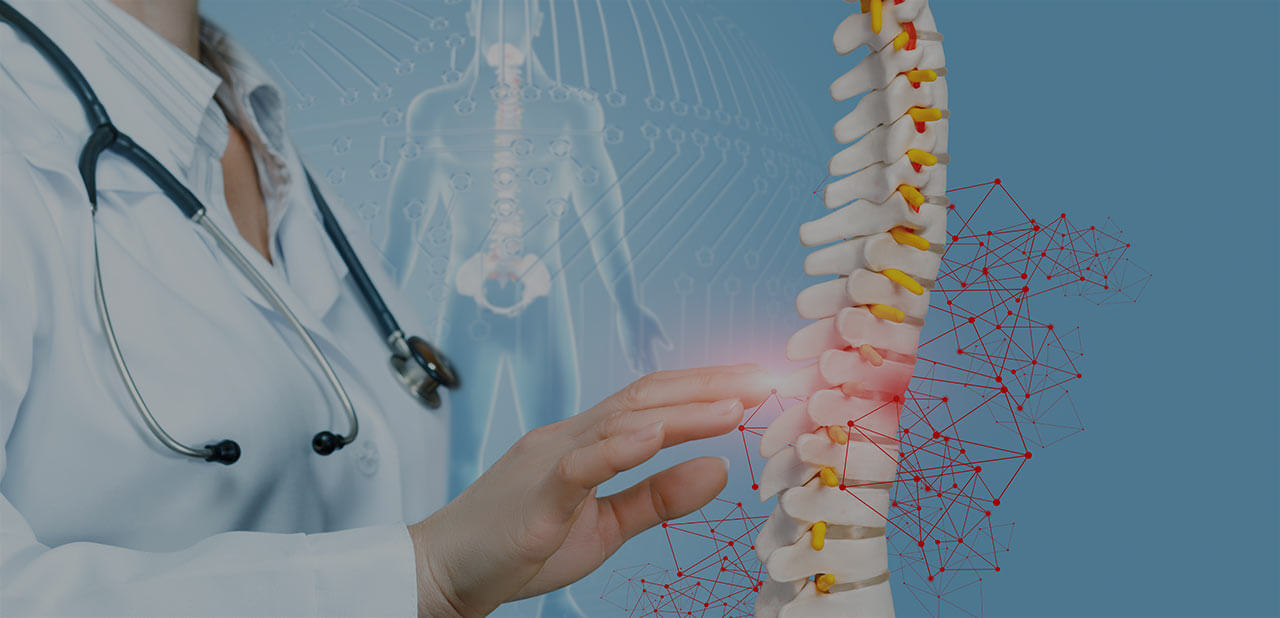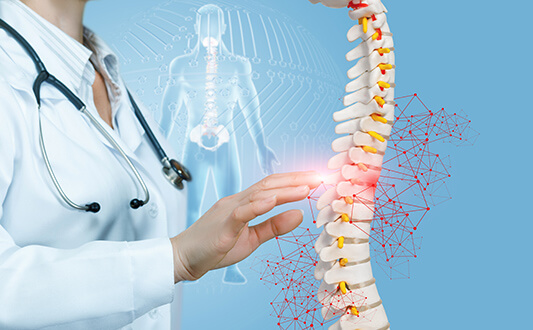Minimally invasive technologies were introduced to the spinal surgery sphere later than other surgical fields. This was due to the difficulty of forming the full-fledged surgical access and imaging of the spinal cord while working with miniature endoscopic instruments through small incisions in the surrounding tissues.
Nevertheless, after the beginning of active CT and MRI use, a better understanding of the spine biomechanics has led to a broader introduction of microsurgical procedures into clinical practice. The development of more advanced instruments and surgical techniques has also contributed to this. Today, minimally invasive spinal surgery ranks among the list of first-line procedures in case of conservative treatment ineffectiveness.
Content
- What types of diseases can be cured with minimally invasive surgery?
- Types of minimally invasive surgical procedures
- Course of the surgical intervention
- Benefits of minimally invasive surgery compared to the conventional one
- Choosing a hospital for undergoing treatment
- How to receive treatment in a foreign hospital?
What types of diseases can be cured with minimally invasive surgery?
According to the World Health Organization, back pain, or spinal pain, occurs at least once in a lifetime in 80% of the world's population. Moreover, more than 2% of patients require surgical treatment. Minimally invasive surgeries are performed in the case of lack of effect from conservative therapy and physiotherapy in the following conditions:
- Spinal disc herniation
- Congenital malformations of the spine, such as spina bifida
- Degenerative vertebral changes
- Traumatic spinal injuries, including compression fractures
- Persistent vertebral column deformities, such as scoliosis
- Spinal instability, spinal stenosis
- Tumors of the spine and spinal cord
- Infectious vertebral lesions, including infectious spondylodiscitis
While choosing appropriate candidates for microsurgical interventions, such aspects as age, weight, and concomitant pathology presence are taken into account. Also, the equipment of the hospital significantly influences the choice of the surgical technique. In order to carry out the endoscopic operation, the medical facility must have the appropriate equipment and specialists who are authorized to work with it.
Types of minimally invasive surgical procedures
Microsurgical techniques are most widely used for the following types of interventions:
- Discectomy is a resection or total removal of the herniated spinal disc followed by replacement surgery. It is often used for the treatment of lumbar spinal disc herniation.
- Spinal cord decompression, or laminectomy, is most often performed in the lumbar spine pathologies. During the operation, part of the arc of the lumbar vertebra is removed. Due to this, pressure on the spinal cord and the spinal nerve roots is reduced. In addition, intervertebral joints and pathologically changed spinal ligaments can be removed.
- Transforaminal lumbar interbody fusion is performed in case of degenerative changes in the intervertebral discs, recurrent hernias, displacement (spondylolisthesis), or vertebral instability.
- Treatment of radiculopathies. In persistent spinal pain and irreversible changes in the nerve endings, the affected roots of the spinal nerves are intersected. Another effective therapy method is the implantation of an infusion pump for the injection of painkillers directly into the affected nerve region.
Depending on the type of surgery, various endoscopic systems and treatment programs are used, for example:
- TESSYS is the transforaminal access system. Access to spine and spinal cord structures through the enlarged intervertebral foramen is the safest and is used in patients of all ages.
- iLESSYS is the system for intralaminar access. The system is used in interventions on the dorsal part of the spinal canal. Access to the surgical field is created through an opening in the arch of the vertebra in a place that was previously determined by means of CT/MRI.
- CESSYS is the system for cervical spinal disc herniation surgery. The system creates anterolateral access through the body of the intervertebral disc. This approach is used in the treatment of cervical spinal disc herniation in Germany.
- MultiZYTE RT is the system for radiofrequency endoscopic rhizotomy. The system is designed specifically for interventions on the intervertebral joints and is used in the treatment of "facet syndrome."
Surgical equipment is constantly being modified according to new scientific inventions. For example, the software for preliminary computer simulation of the operation course and the intraoperative neuromonitoring and monitored anesthesia care techniques are constantly updated.
Course of the surgical intervention
Surgical interventions on the spine are performed by operating orthopedists with an additional specialization in neurosurgery. Also, German surgeons receive an additional certification, which allows them to perform endoscopic operations.
The antibiotic prophylaxis is carried out before the operation using broad-spectrum drugs. This is a preventive measure that minimizes the risk of infectious complications. A patient also receives anesthesia. Depending on the planned surgical technique, the anesthesia can be local (a patient is conscious during the procedure) or general (the patient is in the state of medication sleep).
After the start of anesthesia action, the medical team assesses such vital signs as pulse, blood pressure, oxygen saturation, and ECG. Under accurate monitoring, a surgeon makes a small incision near the affected spinal area. A tubular retractor is introduced through the incision. The device provides access to the surgical field without extensive dissection of tissues and blood vessels.
A specialist introduces miniature surgical instruments, a camera, and a light source through the retractor. If necessary, the intervertebral discs or vertebral bodies are replaced in the same way. After that, the surgeon performs necessary actions under the visual guidance or, in some cases, under the CT/MRI control. For additional protection of the spinal cord, an O-shaped arm is used. This is the computer-assisted neuronavigation system.
After the operation, the surgical instruments and the retractor are removed from the wound, and skin incisions are closed with a single suture or surgical glue. A small dressing is applied to the damaged area. Repeated antibiotic prophylaxis is carried out during the postoperative period, and if necessary, over-the-counter pain medications are prescribed.
Benefits of minimally invasive surgery compared to the conventional one
In comparison with conventional open surgery, minimally invasive interventions have a number of significant benefits, such as:
- Simple preoperative preparation includes quitting smoking, temporarily stopping anticoagulant intake (such as aspirin), and carrying out new MRI or X-ray examinations. Also, the patient should not eat or drink after midnight before the operation.
- Preliminary 3D planning of the operation using a computer. For example, during the diagnostics of spinal disc herniation, CT, MRI, or MSCT is required. Also, a computer-assisted neuronavigation system is used during the operation to protect the spinal cord and increase the accuracy of manipulations.
- Reduced risk of paravertebral muscle damage. During the operation, the muscles are mainly moved apart in a "blunt" way, without dissection. After the removal of microsurgical instruments, the muscle function is fully restored.
- Reducing the of developing infectious complications due to primary antibiotic prophylaxis and maximum preservation of the skin integrity.
- Minor intraoperative blood loss. Magnifying optical instruments used for surgical field visualization allow the surgeon to see the blood vessels and not dissect them during the operation.
- Less pronounced postoperative pain syndrome, the patients do not need to take painkillers for a long time. It also eliminates the risk of developing psychological dependence on analgesics.
- Faster recovery after surgery, a short rehabilitation period. The patient is discharged from the hospital on the second or third day after surgery. Certain microsurgical interventions are even performed on an outpatient basis.
- Good cosmetic result. The skin incisions of 2-3 cm are sufficient for the introduction of endoscopic instruments. Such incisions are closed with single sutures and heal without scarring.
In addition to the obvious benefits, microsurgical interventions are more cost-effective. The cost of the procedure often exceeds the cost of traditional open surgery. However, a short hospitalization period and quick recovery significantly reduce the total treatment cost. Due to this, microsurgical interventions are covered by large insurance companies.
Choosing a hospital for undergoing treatment
The countries of central and western Europe, particularly Germany, are leading in endoscopic and minimally invasive surgery. Paradoxically, the list of indications for spinal surgery is nine times shorter here than in the CIS or Arab countries since doctors use all the possibilities of conservative treatment. The diagnostics in Germany allow them to detect pathology at the early stages.
Nevertheless, in the presence of absolute indications for surgery, treatment in German hospitals is carried out with a minimum complication rate (up to 0,1-1,0%) and accuracy of 98,9%. For example, according to the summary statistics for 2017, more than 1,658 robotic interventions were successfully carried out in German medical centers. The most reputable German hospitals in this field are:
- University Hospital Würzburg, Department of Adult and Pediatric Orthopedics
- University Hospital Hamburg-Eppendorf, Department of Adult and Pediatric Neurosurgery
- University Hospital Erlangen, Department of Adult and Pediatric Neurosurgery
- University Hospital Carl Gustav Carus Dresden, Department of Adult and Pediatric Orthopedics, Trauma Surgery
- Charite University Hospital Berlin, Department of Adult and Pediatric Neurosurgery
As a rule, in large university hospitals, children and adults undergo treatment in the same department. This additionally confirms the high qualification of operating orthopedists and neurosurgeons, who consider the specificities of operations in patients of different age categories.
How to receive treatment in a foreign hospital?
In most cases, the world's leading university hospitals have quotas for the treatment of international patients. If the documents are prepared correctly, the administrative staff registers the request and puts the patient on a waiting list. As a rule, the waiting period for high-tech medical care exceeds 1-2 months.
If you need to undergo treatment in a shorter time or have a comfortable and safe trip to a foreign hospital, you can contact Booking Health. Booking Health is the only medical tourism provider, which helps patients from 75 countries undergo the necessary treatment or examination abroad.
Specialists of Booking Health will support you in such important aspects as:
- Selection of the right hospital based on the annual qualification profile
- Establishment of direct communication with your attending physician
- Preparation of a medical program in advance, without repeating previous examinations
- Provision of favorable costs for treatment in Germany, without overpricing and additional coefficients for foreign patients (saving up to 50%)
- Booking the appointment with a doctor on the necessary date
- Monitoring of the medical program at all its stages
- Assistance in buying and forwarding medicines
- Communication with the hospital after treatment completion
- Control of invoices and return of unspent funds
- Organization of additional examinations
- Top-class service: booking hotels and plane tickets, transfer organization
Please leave a request on the company's official website and wait for a call from a medical consultant who will study your situation in detail, give recommendations on the treatment options, and prepare for the trip. After that, during treatment in Germany, you will be accompanied by a qualified interpreter. Also, a personal coordinator will constantly be in touch with you, helping with all medical and non-medical issues.
Choose treatment abroad and you will for sure get the best results!
See the interview for more information:
SAFE AND EFFECTIVE SPINAL SURGERY IN GERMANY – interview with Dr. med. Andrej Bitter
Authors:
The article was edited by medical experts, board certified doctors Dr. Nadezhda Ivanisova, Dr. Sergey Pashchenko. For the treatment of the conditions referred to in the article, you must consult a doctor; the information in the article is not intended for self-medication!
Sources:
National Center for Biotechnology
Read:
Why Booking Health - questions and answers
How to make right decision when choosing the clinic and specialist
7 reasons to trust to the rating of clinics on the Booking Health portal
Don't know where to start?
Contact Booking Health






